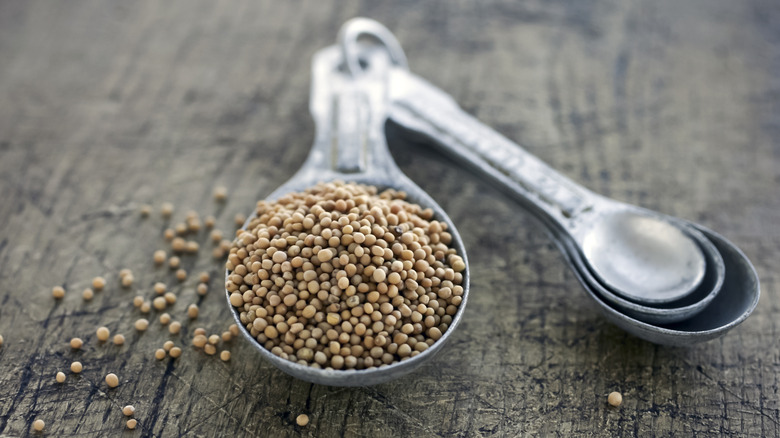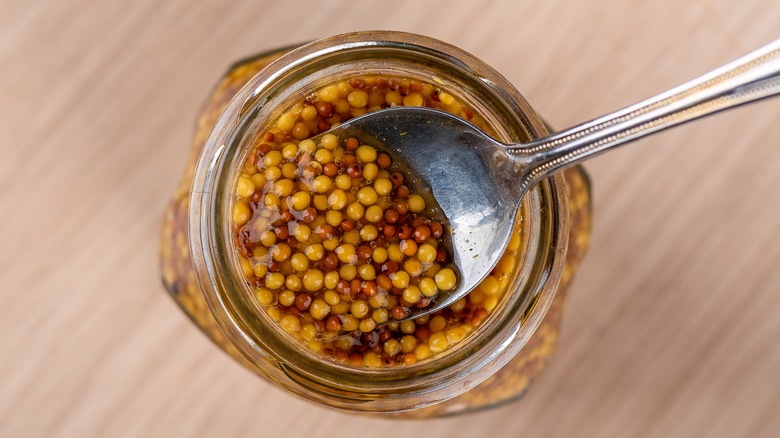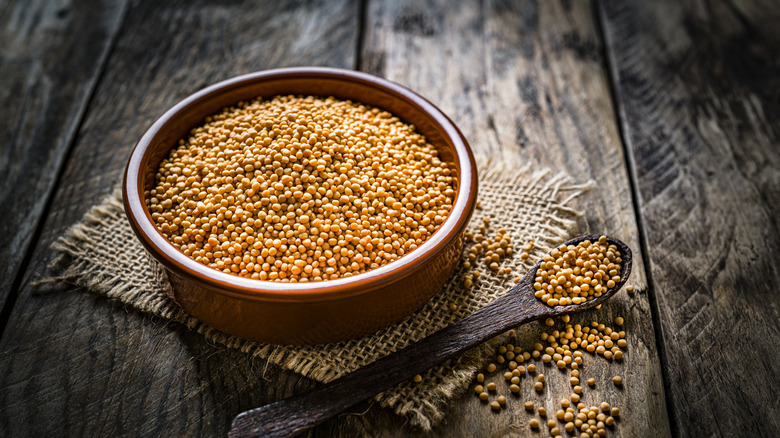Pickled Mustard Seeds Are The Secret Ingredient For Flavor-Packed Vinaigrettes
Whether it is because of the nickname mustard caviar or just offering a punch of flavor, pickled mustard seeds are many chefs' secret ingredient. To avoid a one-note vinaigrette, these little flavor gems burst with vibrant flavor.
A basic vinaigrette combines acid and an emulsifier, often vinegar and oil. Seasonings, whether onions, herbs, or spices, add additional flavors, but with pickled mustard seeds, the additional ingredient ensures that the highs and lows shine in every bite.
Since the mustard seeds burst with the pickling liquid, the flavor is zesty, tangy, and a touch spicy. More importantly, within the vinaigrette, the little spheres add texture. It breaks up the liquid without becoming intrusive and creates almost like a little flavor treasure that can attach to a piece of tomato. Unlike a large piece of pickled onion, it can go slightly unnoticed until the flavor hits the tongue. After trying this ingredient hack in a recipe, many people will keep a jar in the refrigerator and look for opportunities to use the pickled mustard seeds.
How to make pickled mustard seeds
Unlike mustard powder or spreadable mustard with its sharpness, pickled mustard seeds bring together a tangy, sweet, and spicy flavor. Making them requires a two-step process. First, the mustard seeds should be boiled and drained. Blanching them first helps to remove some bitter notes.
Second, the mustard seeds are simmered in a brine. Cooks can vary their brine recipe based on personal preferences. A basic brine includes salt, sugar, acid, water, and sometimes other ingredients for flavor. For about 15-20 minutes, the mustard seeds sit in the brine. Once they have plumped, remove them from the pickling liquid and allow them to cool. Since that bursting quality is important to eating enjoyment, it is paramount that the seed absorbs ample liquid.
While the mustard seeds can be used after they cool, the flavor is more robust after resting for a few days in the refrigerator. If stored well, the airtight jar can last about a month.
Since the basic method can vary, cooks can experiment with various brine flavors. From amplifying the spice notes with pepper or highlighting an earthy tone with herbs, the condiment can be one part flavor and another part science experiment. Sometimes, the secret ingredient to a flavorful dish is the food that might be overlooked at first glance.
Pickled mustard seeds add zing to many dishes
While a teaspoon of pickled mustard seeds can brighten a vinaigrette, those flavor-packed spheres can boost many sauces. From stirring in a scoop into ranch or even a pasta sauce, the combination of briny, spicy, and pungent balances flavors without overtaking the composed bite.
For example, a dollop of pickled mustard seeds can elevate the dish instead of a spicy slice of jalapeno on a deviled egg. This form of caviar is much less expensive but adds both the flavor and textural component to contrast the creaminess of the egg.
Even using the seeds as an alternative to capers in a dish could be nice. While slightly less briny, the mustard seeds could easily work in a tartare. That little burst would contrast the softer raw meat and break up the unctuous quality with the raw egg.
Given the myriad of uses, having a jar of pickled mustard seeds sitting in the refrigerator seems beneficial. It might not be the most common recipe ingredient, but it could be that go-to secret chef hack that gives a home cook more culinary confidence.


